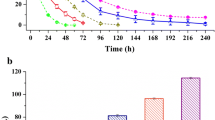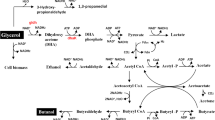Abstract
Microbial preference for glucose implies incomplete and/or slow utilization of lignocellulose hydrolysates, which is caused by the regulatory mechanism named carbon catabolite repression (CCR). In this study, a 2,3-butanediol (2,3-BD) producing Klebsiella oxytoca strain was engineered to eliminate glucose repression of xylose utilization. The crp(in) gene, encoding the mutant cyclic adenosine monophosphate (cAMP) receptor protein CRP(in), which does not require cAMP for functioning, was characterized and overexpressed in K. oxytoca. The engineered recombinant could utilize a mixture of glucose and xylose simultaneously, without CCR. The profiles of sugar consumption and 2,3-BD production by the engineered recombinant, in glucose and xylose mixtures, were examined and showed that glucose and xylose could be consumed simultaneously to produce 2,3-BD. This study offers a metabolic engineering strategy to achieve highly efficient utilization of sugar mixtures derived from the lignocellulosic biomass for the production of bio-based chemicals using enteric bacteria.


Similar content being viewed by others
References
Bothast RJ, Saha BC, Flosenzier AV, Ingram LO (1994) Fermentation of L-arabinose, D-xylose and D-glucose by ethanologenic recombinant Klebsiella oxytoca strain P2. Biotechnol Lett 16:401–406
Celińska E, Grajek W (2009) Biotechnological production of 2, 3-butanediol—current state and prospects. Biotechnol Adv 27:715–725
Cheng KK, Liu Q, Zhang JA, Li JP, Xu JM, Wang GH (2010) Improved 2, 3-butanediol production from corncob acid hydrolysate by fed-batch fermentation using Klebsiella oxytoca. Process Biochem 45:613–616
Dien B, Nichols N, Bothast R (2002) Fermentation of sugar mixtures using Escherichia coli catabolite repression mutants engineered for production of L-lactic acid. J Ind Microbiol Biotechnol 29:221–227
Eppler T, Boos W (1999) Glycerol-3-phosphate-mediated repression of malT in Escherichia coli does not require metabolism, depends on enzyme IIA(Glc) and is mediated by cAMP levels. Mol Microbiol 33:1221–1231
Görke B, Stülke J (2008) Carbon catabolite repression in bacteria: many ways to make the most out of nutrients. Nat Rev Microbiol 6:613–624
Gosset G (2005) Improvement of Escherichia coli production strains by modification of the phosphoenolpyruvate:sugar phosphotransferase system. Microb Cell Fact 4:14–27
Harman JG, McKenney K, Peterofsky A (1986) Structure-function analysis of three cAMP-independent forms of the cAMP receptor protein. J Biol Chem 261:16332–16339
Hernández-Montalvo V, Valle F, Bolivar F, Gosset G (2001) Characterization of sugar mixtures utilization by an Escherichia coli mutant devoid of the phosphotransferase system. Appl Microbiol Biotechnol 43:70–75
Hernández-Montalvo V, Martinez A, Hernández-Chavez G, Bolivar F, Valle F, Gosset G (2003) Expression of galP and glk in a Escherichia coli PTS mutant restores glucose transport and increases glycolytic flux to fermentation products. Biotechnol Bioeng 83:687–694
Jeong KJ, Lee HS, Lee SY, Chang YK (1998) Efficient transformation of Klebsiella oxytoca by electroporation. Biotechnol Bioprocess Eng 3:48–49
Ji XJ, Huang H, Li S, Du J, Lian M (2008) Enhanced 2, 3-butanediol production by altering the mixed acid fermentation pathway in Klebsiella oxytoca. Biotechnol Lett 30:731–734
Ji XJ, Huang H, Du J, Zhu JG, Ren LJ, Hu N, Li S (2009a) Enhanced 2, 3-butanediol production by Klebsiella oxytoca using a two-stage agitation speed control strategy. Bioresour Technol 100:3410–3414
Ji XJ, Huang H, Du J, Zhu JG, Ren LJ, Li S, Nie ZK (2009b) Development of an industrial medium for economical 2, 3-butanediol production through co-fermentation of glucose and xylose by Klebsiella oxytoca. Bioresour Technol 100:5214–5218
Ji XJ, Huang H, Zhu JG, Ren LJ, Nie ZK, Du J, Li S (2010) Engineering Klebsiella oxytoca for efficient 2, 3-butanediol production through insertional inactivation of acetaldehyde dehydrogenase gene. Appl Microbiol Biotechnol 85:1751–1758
Jojima T, Omumasaba CA, Inui M, Yukawa H (2010) Sugar transporters in efficient utilization of mixed sugar substrates: current knowledge and outlook. Appl Microbiol Biotechnol 85:471–480
Joseph S, David WR (2001) Molecular cloning: a laboratory manual (Third edition). Cold Spring harbor laboratory Press, Cold Spring Harbor
Kleiner D, Paul W, Merrick MJ (1988) Construction of multicopy expreesion vectors for regulated overproduction of proteins in Klebsiella pneumoniae and other enteric bacteria. J Gen Microbiol 134:1779–1784
Kosaric N, Magee R, Blaszczyk R (1990) Production of 2, 3-butanediol from glucose and xylose by Klebsiella pneumoniae. Chem Biochem Eng Q 4:123–126
Li ZT, Sun YC, Mao XJ, Wang YP (2002) The cAMP receptor protein (CRP) down-regulates Klebsiella pneumoniae nif promoters in Echerichia coli. Chin Sci Bull 47:1622–1628
Li R, Chen Q, Wang P, Qi Q (2007) A novel-designed Escherichia coli for the production of various polyhydroxyalkanoates from inexpensive substrate mixture. Appl Microbiol Biotechnol 75:1103–1109
Li ZJ, Ji XJ, Kan SL, Qiao HQ, Jiang M, Lu DQ, Wang J, Huang H, Jia HH, Ouyuang PK, Ying HJ (2010) Past, present, and future industrial biotechnology in China. Adv Biochem Eng Biotechnol 122:1–42
Lindsay SE, Bothast RJ, Ingram LO (1995) Improved strains of recombinant Escherichia coli for ethanol production from sugar mixtures. Appl Microbiol Biotechnol 43:70–75
Moniruzzaman M, Dien BS, Ferrer B, Hespell RB, Dale BE, Ingram LO, Bothast RJ (1996) Ethanol production from AFEX pretreated corn fiber by recombinant bacteria. Biotechnol Lett 18:985–990
Nichols NN, Dien BS, Bothast RJ (2001) Use of catabolite repression mutants for fermentation of sugar mixtures to ethanol. Appl Microbiol Biotechnol 56:120–125
Osuna R, Bender RA (1991) Klebsiella aerogenes catabolite gene activator protein and the gene encoding it (crp). J Bacteriol 173:6626–6631
Postma PW, Lengeler JW, Jacobson GR (1993) Phosphoenolpyruvate: carbohydrate phosphotransferase system of bacteria. Microbiol Rev 57:543–594
Ragauskas AJ, Williams CK, Davison BH, Britovsek G, Cairney J, Eckert CA, Frederick WJ Jr, Hallett JP, Leak DJ, Liotta CL, Mielenz JR, Murphy R, Templer R, Tschaplinski T (2006) The path forward for biofuels and biomaterials. Science 311:484–498
Riley M, Abe T, Arnaud MB, Berlyn MK, Blattner FR, Chaudhuri RR, Glasner JD, Horiuchi T, Keseler IM, Kosuge T, Mori H, Perna NT, Plunkett G III, Rudd KE, Serres MH, Thomas GH, Thomson NR, Wishart D, Wanner BL (2006) Escherichia coli K12: a cooperatively developed annotation snapshot—2005. Nucleic Acids Res 34:1–9
Roseman S, Meadow ND (1990) Signal transduction by bacterial phosphotransferase system. J Biol Chem 265:2993–2996
Saier MH Jr, Ramseier TM (1996) The catabolite repressor/activator (Cra) protein of enteric bacteria. J Bacteriol 178:3411–3417
Sheehan J, Himmel M (1999) Enzymes, energy, and the environment: a strategic perspective on the U.S. Department of Energy’s Research and Development activities for bioethanol. Biotechnol Prog 15:817–827
Snoep JL, Arfman N, Yomano LP, Fliege RK, Conway T, Ingram LO (1994) Reconstitution of glucose uptake and phosphorylation in a glucose-negative mutant of Escherichia coli by using Zymomonas mobilis genes encoding the glucose facilitator protein and glucokinase. J Bacteriol 176:2133–2135
Stephanopoulos G (2007) Challenges in engineering microbes for biofuels production. Science 315:801–804
Syu MJ (2001) Biological production of 2, 3-butanediol. Appl Microbiol Biotechnol 55:10–18
van Haveren J, Scott EL, Sanders J (2008) Bulk chemicals from biomass. Biofuels Bioprod Bioref 2:41–57
Wang Q, Wu C, Chen T, Chen X, Zhao X (2005) Expression of galactose permease and pyruvate carboxylase in Escherichia coli ptsG mutant increases the growth rate and succinate yield under anaerobic conditions. Biotechnol Lett 28:89–93
Wang A, Wang Y, Jiang T, Li L, Ma C, Xu P (2010) Production of 2, 3-butanediol from corncob molasses, a waste by-product in xylitol production. Appl Microbiol Biotechnol 87:965–970
Wood BE (2005) Improving Klebsiella oxytoca for ethanol production from lignocellulosic biomass. Ph.D. Thesis, Department of Microbiology and Cell Science, University of Florida
Yan L, Zhang H, Chen J, Lin Z, Jin Q, Jia H, Huang H (2009) Dilute sulfuric acid cycle spray flow-through pretreatment of corn stover for enhancement of sugar recovery. Bioresour Technol 100:1803–1808
Zhu JG, Li S, Ji XJ, Huang H, Hu N (2009) Enhanced 1, 3-propanediol production in recombinant Klebsiella pneumoniae carrying the gene yqhD encoding 1, 3-propanediol oxidoreductase isoenzyme. World J Microbiol Biotechnol 25:1217–1223
Acknowledgements
We are grateful to Prof. Mike J. Merrick, John Innes Centre, UK, and Prof. Lonnie O. Ingram, University of Florida, USA, for providing the pDK7 and pLOI 3244 plasmids. This work was financially supported by the National Natural Science Foundation of China (Nos. 20606018 and 21006049), the Key Program of National Natural Science Foundation of China (No. 20936002), the National Basic Research Program of China (Nos. 2007CB707805, 2009CB724700 and 2011CB200906), and the Program for New Century Excellent Talents in University from the Ministry of Education of China (No. NCET-09-0157). X.-J. Ji was supported by the Innovation Fund for Doctoral Dissertation of Nanjing University of Technology (No. BSCX200808), the China Postdoctoral Science Foundation Funded Project (No. 20100471328) and the Jiangsu Planned Projects for Postdoctoral Research Funds of China (No. 1001015 C).
Author information
Authors and Affiliations
Corresponding author
Electronic supplementary material
Below is the link to the electronic supplementary material.
Supplementary Fig. S1
Alignments of cloned nucleotide sequence containing coding regions for crp(in) from Escherichia coli ET25 (GenBank accession no. HM595439) and crp from E. coli K12 (NC000913), Klebsiella pneumoniae MGH 78578 (CP000647), Klebsiella oxytoca M5al (AJ278967), and Klebsiella aerogenes KC1043 (M68973) searched from GenBank data. Nucleotides differing in E. coli ET25 are surrounded with rectangles (DOC 1,259 kb)
Supplementary Fig. S2
Alignments of amino acid sequences of CRP(in) of Escherichia coli ET25 (ADK89557.1) and CRP of E. coli K12 (AP_004432), Klebsiella pneumoniae MGH 78578 (YP 001337397), Klebsiella oxytoca M5al (CAC07215) and Klebsiella aerogenes KC1043 (AAA25058). Amino acids differing in E. coli ET25 are surrounded with rectangles (DOC 1,140 kb)
Rights and permissions
About this article
Cite this article
Ji, XJ., Nie, ZK., Huang, H. et al. Elimination of carbon catabolite repression in Klebsiella oxytoca for efficient 2,3-butanediol production from glucose–xylose mixtures. Appl Microbiol Biotechnol 89, 1119–1125 (2011). https://doi.org/10.1007/s00253-010-2940-5
Received:
Revised:
Accepted:
Published:
Issue Date:
DOI: https://doi.org/10.1007/s00253-010-2940-5




